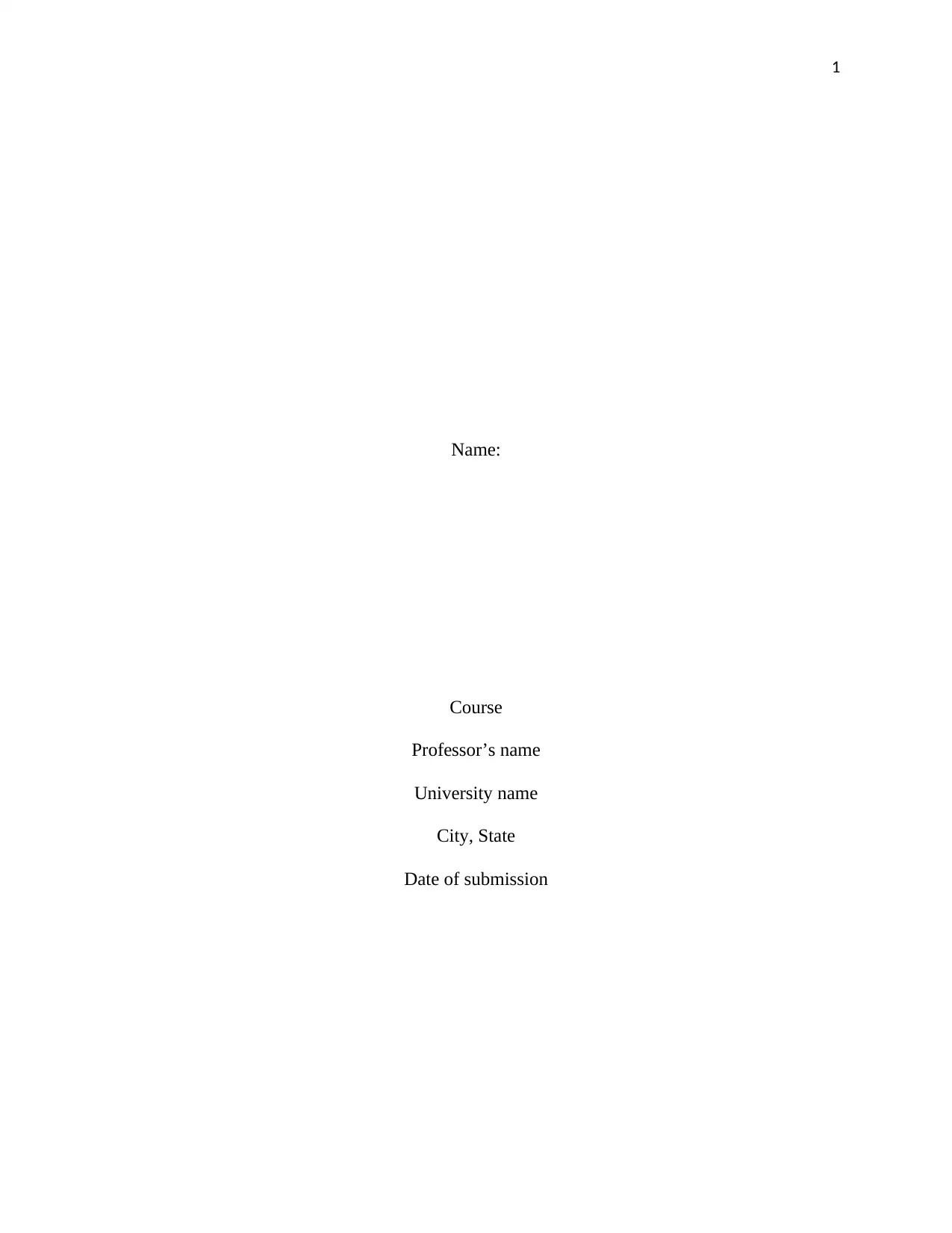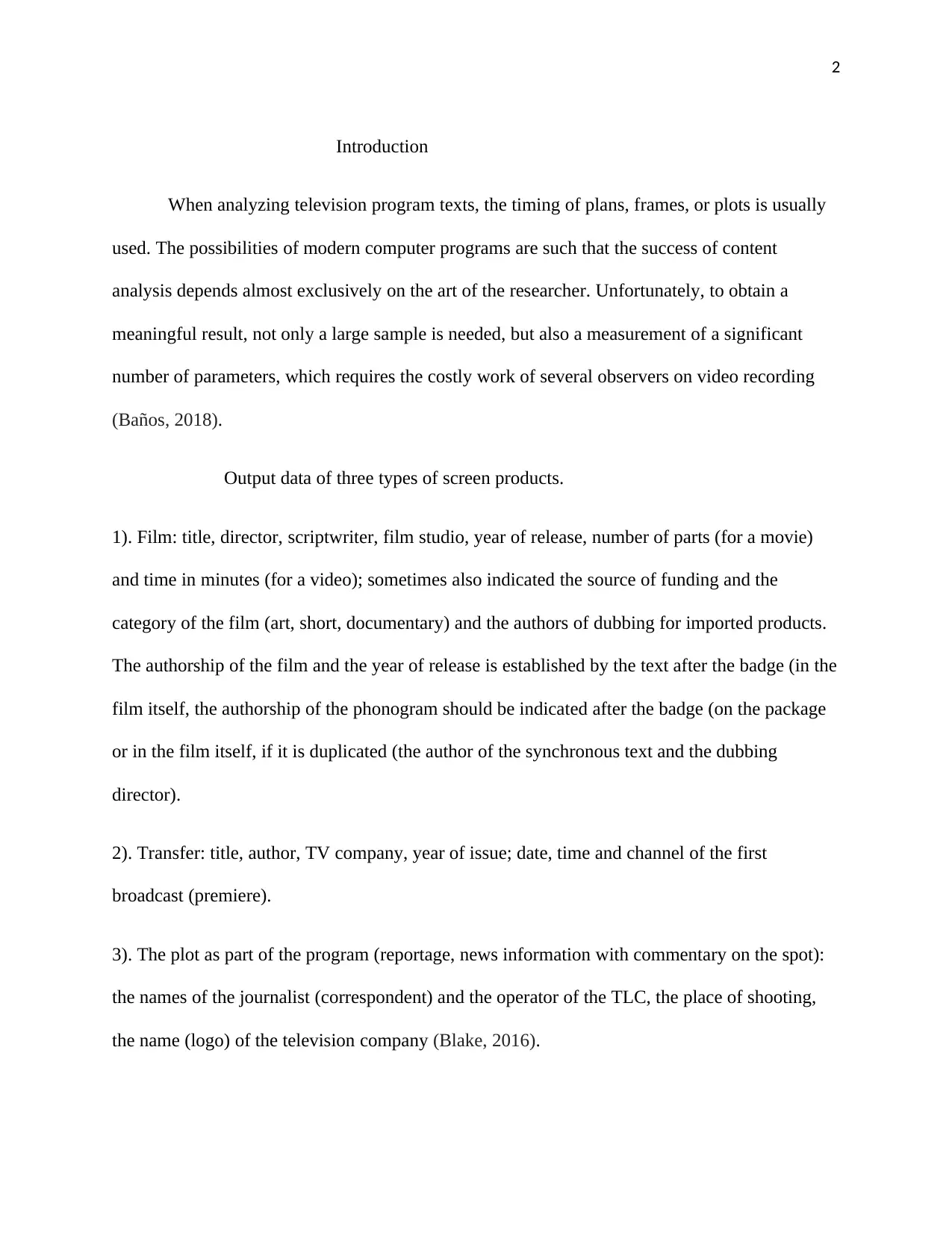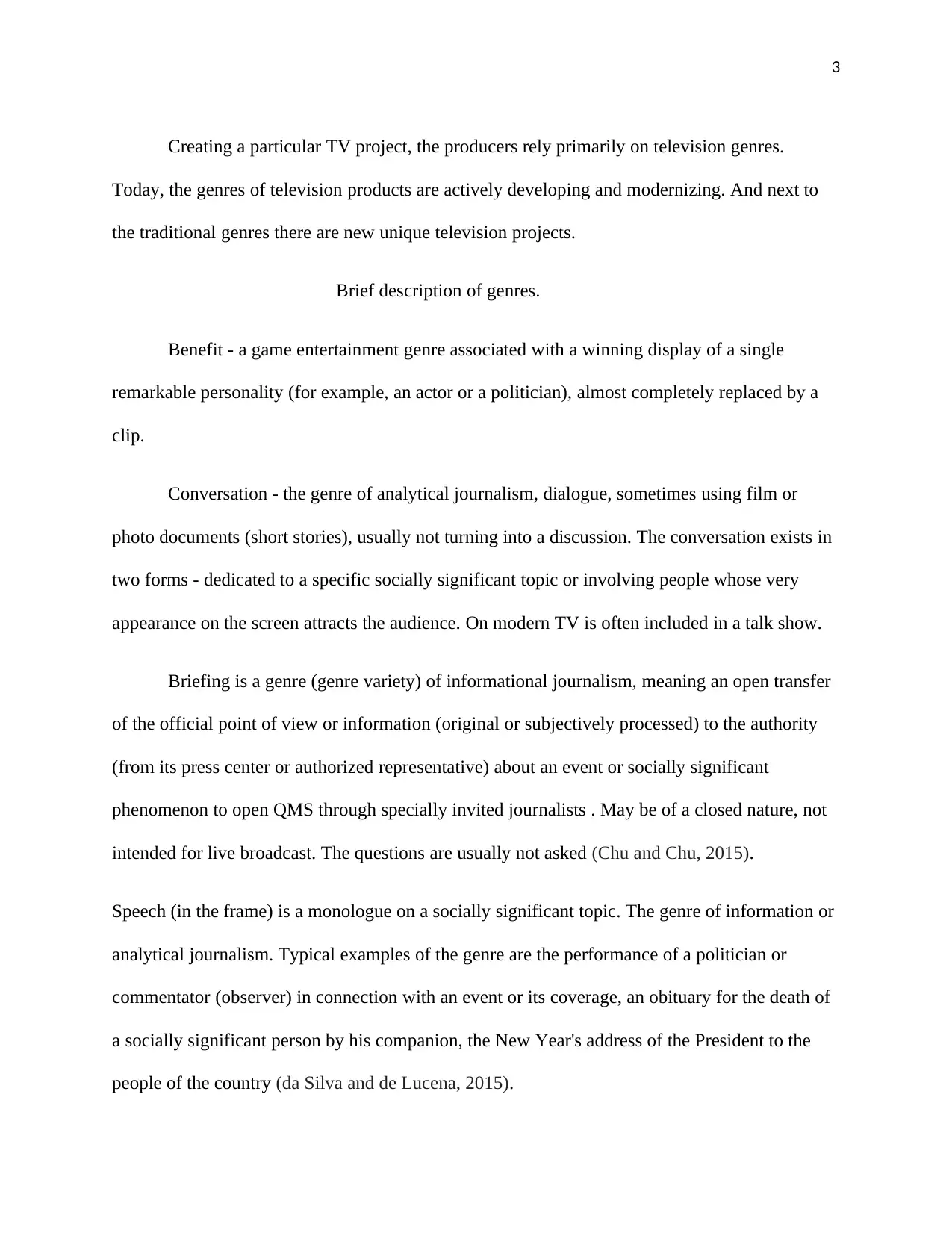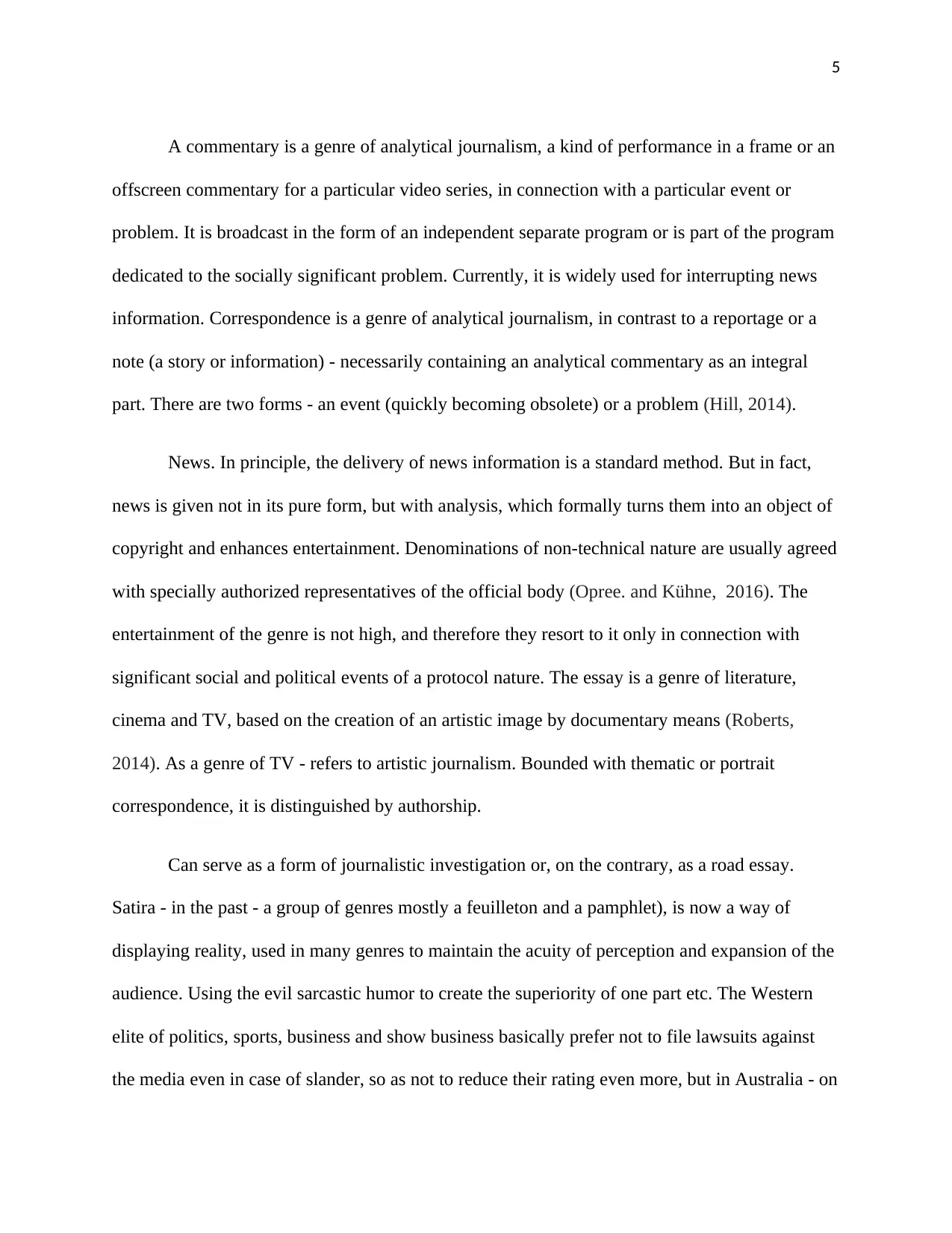Analysis of Television Program Texts: Genres and Changes in Broadcasting Grid
VerifiedAdded on 2023/06/08
|9
|2287
|211
AI Summary
This article analyzes the genres of television programs and changes in broadcasting grid over the years. The study uses content analysis as the method of research. The article provides a brief description of various genres of television programs and their characteristics. It also discusses the impact of television on the psyche of viewers. The article concludes with a comparison of the number of programs in different genres between 2005 and 2013.
Contribute Materials
Your contribution can guide someone’s learning journey. Share your
documents today.

1
Name:
Course
Professor’s name
University name
City, State
Date of submission
Name:
Course
Professor’s name
University name
City, State
Date of submission
Secure Best Marks with AI Grader
Need help grading? Try our AI Grader for instant feedback on your assignments.

2
Introduction
When analyzing television program texts, the timing of plans, frames, or plots is usually
used. The possibilities of modern computer programs are such that the success of content
analysis depends almost exclusively on the art of the researcher. Unfortunately, to obtain a
meaningful result, not only a large sample is needed, but also a measurement of a significant
number of parameters, which requires the costly work of several observers on video recording
(Baños, 2018).
Output data of three types of screen products.
1). Film: title, director, scriptwriter, film studio, year of release, number of parts (for a movie)
and time in minutes (for a video); sometimes also indicated the source of funding and the
category of the film (art, short, documentary) and the authors of dubbing for imported products.
The authorship of the film and the year of release is established by the text after the badge (in the
film itself, the authorship of the phonogram should be indicated after the badge (on the package
or in the film itself, if it is duplicated (the author of the synchronous text and the dubbing
director).
2). Transfer: title, author, TV company, year of issue; date, time and channel of the first
broadcast (premiere).
3). The plot as part of the program (reportage, news information with commentary on the spot):
the names of the journalist (correspondent) and the operator of the TLC, the place of shooting,
the name (logo) of the television company (Blake, 2016).
Introduction
When analyzing television program texts, the timing of plans, frames, or plots is usually
used. The possibilities of modern computer programs are such that the success of content
analysis depends almost exclusively on the art of the researcher. Unfortunately, to obtain a
meaningful result, not only a large sample is needed, but also a measurement of a significant
number of parameters, which requires the costly work of several observers on video recording
(Baños, 2018).
Output data of three types of screen products.
1). Film: title, director, scriptwriter, film studio, year of release, number of parts (for a movie)
and time in minutes (for a video); sometimes also indicated the source of funding and the
category of the film (art, short, documentary) and the authors of dubbing for imported products.
The authorship of the film and the year of release is established by the text after the badge (in the
film itself, the authorship of the phonogram should be indicated after the badge (on the package
or in the film itself, if it is duplicated (the author of the synchronous text and the dubbing
director).
2). Transfer: title, author, TV company, year of issue; date, time and channel of the first
broadcast (premiere).
3). The plot as part of the program (reportage, news information with commentary on the spot):
the names of the journalist (correspondent) and the operator of the TLC, the place of shooting,
the name (logo) of the television company (Blake, 2016).

3
Creating a particular TV project, the producers rely primarily on television genres.
Today, the genres of television products are actively developing and modernizing. And next to
the traditional genres there are new unique television projects.
Brief description of genres.
Benefit - a game entertainment genre associated with a winning display of a single
remarkable personality (for example, an actor or a politician), almost completely replaced by a
clip.
Conversation - the genre of analytical journalism, dialogue, sometimes using film or
photo documents (short stories), usually not turning into a discussion. The conversation exists in
two forms - dedicated to a specific socially significant topic or involving people whose very
appearance on the screen attracts the audience. On modern TV is often included in a talk show.
Briefing is a genre (genre variety) of informational journalism, meaning an open transfer
of the official point of view or information (original or subjectively processed) to the authority
(from its press center or authorized representative) about an event or socially significant
phenomenon to open QMS through specially invited journalists . May be of a closed nature, not
intended for live broadcast. The questions are usually not asked (Chu and Chu, 2015).
Speech (in the frame) is a monologue on a socially significant topic. The genre of information or
analytical journalism. Typical examples of the genre are the performance of a politician or
commentator (observer) in connection with an event or its coverage, an obituary for the death of
a socially significant person by his companion, the New Year's address of the President to the
people of the country (da Silva and de Lucena, 2015).
Creating a particular TV project, the producers rely primarily on television genres.
Today, the genres of television products are actively developing and modernizing. And next to
the traditional genres there are new unique television projects.
Brief description of genres.
Benefit - a game entertainment genre associated with a winning display of a single
remarkable personality (for example, an actor or a politician), almost completely replaced by a
clip.
Conversation - the genre of analytical journalism, dialogue, sometimes using film or
photo documents (short stories), usually not turning into a discussion. The conversation exists in
two forms - dedicated to a specific socially significant topic or involving people whose very
appearance on the screen attracts the audience. On modern TV is often included in a talk show.
Briefing is a genre (genre variety) of informational journalism, meaning an open transfer
of the official point of view or information (original or subjectively processed) to the authority
(from its press center or authorized representative) about an event or socially significant
phenomenon to open QMS through specially invited journalists . May be of a closed nature, not
intended for live broadcast. The questions are usually not asked (Chu and Chu, 2015).
Speech (in the frame) is a monologue on a socially significant topic. The genre of information or
analytical journalism. Typical examples of the genre are the performance of a politician or
commentator (observer) in connection with an event or its coverage, an obituary for the death of
a socially significant person by his companion, the New Year's address of the President to the
people of the country (da Silva and de Lucena, 2015).

4
Hyperrealism - a new derivative on the basis of the word "realism" actually turned into a
term with the development of animation techniques in the production of television screensavers,
video clips and films such as "Terminator" or "Jurassic Park" - the synthesis of an artificial video
using powerful computer graphics. Hyperrealism - a style in which entertainment is enhanced by
the combination of real images and computer graphics (usually a living actor in the virtual
world) (Fu and Xiang, 2016).
Discussion is a genre of analytical journalism, usually with the participation of a leading
and no less than two carriers of contrasting points of view on a socially significant problem
(Esslin, 2017). Since the discussion is most often broadcast without a video series, entertainment
depends on the leader's professionalism in selecting participants, preparing the problem, and the
ability to improvise during the conversation (Klos, et al., 2015). A variation of the debate are the
debates. On modern TV is often included in a talk show.
A documentary is the main form of the existence of a genre of documentary (also non-
fiction) cinema. Documentary should be based on the shooting of genuine events and it is this
genre that is the ancestor of all the others in the on-screen art. However, film documents by
themselves, no matter how unique the footage and the events depicted, require effort to give
them entertainment and the effect of credibility: editing, mixing, commenting and combining
genres to create a dramatic composition.In theory, there are several branched and interwoven
directions of documentary literature.
TV programming in Journalistic nature
Hyperrealism - a new derivative on the basis of the word "realism" actually turned into a
term with the development of animation techniques in the production of television screensavers,
video clips and films such as "Terminator" or "Jurassic Park" - the synthesis of an artificial video
using powerful computer graphics. Hyperrealism - a style in which entertainment is enhanced by
the combination of real images and computer graphics (usually a living actor in the virtual
world) (Fu and Xiang, 2016).
Discussion is a genre of analytical journalism, usually with the participation of a leading
and no less than two carriers of contrasting points of view on a socially significant problem
(Esslin, 2017). Since the discussion is most often broadcast without a video series, entertainment
depends on the leader's professionalism in selecting participants, preparing the problem, and the
ability to improvise during the conversation (Klos, et al., 2015). A variation of the debate are the
debates. On modern TV is often included in a talk show.
A documentary is the main form of the existence of a genre of documentary (also non-
fiction) cinema. Documentary should be based on the shooting of genuine events and it is this
genre that is the ancestor of all the others in the on-screen art. However, film documents by
themselves, no matter how unique the footage and the events depicted, require effort to give
them entertainment and the effect of credibility: editing, mixing, commenting and combining
genres to create a dramatic composition.In theory, there are several branched and interwoven
directions of documentary literature.
TV programming in Journalistic nature
Secure Best Marks with AI Grader
Need help grading? Try our AI Grader for instant feedback on your assignments.

5
A commentary is a genre of analytical journalism, a kind of performance in a frame or an
offscreen commentary for a particular video series, in connection with a particular event or
problem. It is broadcast in the form of an independent separate program or is part of the program
dedicated to the socially significant problem. Currently, it is widely used for interrupting news
information. Correspondence is a genre of analytical journalism, in contrast to a reportage or a
note (a story or information) - necessarily containing an analytical commentary as an integral
part. There are two forms - an event (quickly becoming obsolete) or a problem (Hill, 2014).
News. In principle, the delivery of news information is a standard method. But in fact,
news is given not in its pure form, but with analysis, which formally turns them into an object of
copyright and enhances entertainment. Denominations of non-technical nature are usually agreed
with specially authorized representatives of the official body (Opree. and Kühne, 2016). The
entertainment of the genre is not high, and therefore they resort to it only in connection with
significant social and political events of a protocol nature. The essay is a genre of literature,
cinema and TV, based on the creation of an artistic image by documentary means (Roberts,
2014). As a genre of TV - refers to artistic journalism. Bounded with thematic or portrait
correspondence, it is distinguished by authorship.
Can serve as a form of journalistic investigation or, on the contrary, as a road essay.
Satira - in the past - a group of genres mostly a feuilleton and a pamphlet), is now a way of
displaying reality, used in many genres to maintain the acuity of perception and expansion of the
audience. Using the evil sarcastic humor to create the superiority of one part etc. The Western
elite of politics, sports, business and show business basically prefer not to file lawsuits against
the media even in case of slander, so as not to reduce their rating even more, but in Australia - on
A commentary is a genre of analytical journalism, a kind of performance in a frame or an
offscreen commentary for a particular video series, in connection with a particular event or
problem. It is broadcast in the form of an independent separate program or is part of the program
dedicated to the socially significant problem. Currently, it is widely used for interrupting news
information. Correspondence is a genre of analytical journalism, in contrast to a reportage or a
note (a story or information) - necessarily containing an analytical commentary as an integral
part. There are two forms - an event (quickly becoming obsolete) or a problem (Hill, 2014).
News. In principle, the delivery of news information is a standard method. But in fact,
news is given not in its pure form, but with analysis, which formally turns them into an object of
copyright and enhances entertainment. Denominations of non-technical nature are usually agreed
with specially authorized representatives of the official body (Opree. and Kühne, 2016). The
entertainment of the genre is not high, and therefore they resort to it only in connection with
significant social and political events of a protocol nature. The essay is a genre of literature,
cinema and TV, based on the creation of an artistic image by documentary means (Roberts,
2014). As a genre of TV - refers to artistic journalism. Bounded with thematic or portrait
correspondence, it is distinguished by authorship.
Can serve as a form of journalistic investigation or, on the contrary, as a road essay.
Satira - in the past - a group of genres mostly a feuilleton and a pamphlet), is now a way of
displaying reality, used in many genres to maintain the acuity of perception and expansion of the
audience. Using the evil sarcastic humor to create the superiority of one part etc. The Western
elite of politics, sports, business and show business basically prefer not to file lawsuits against
the media even in case of slander, so as not to reduce their rating even more, but in Australia - on

6
the contrary, the rating of the media increases even in Today, television is the most mass
communication channel and one of the major factors affecting the personality. Most people
easily fall under the influence of television images. This is due to the specifics of the television
exposure (the use of two channels at once - visual and auditory, various manipulative
technologies), and on the other hand, television viewing is one of the most preferred ways of
spending time.
The filling of the air with telecasts of a certain type, the dominance of certain certain
genres and themes of telecasts has a significant impact on the psyche of viewers. Television
forms a "reasonable person", "a political man", "a person playing", "a musical person". In our
study, we carried out an analysis of the programs of the telecasts of five TV channels: in 2005
and 2013. The goal was to determine the changes in the broadcasting grid in 8 years. The content
analysis was the method of research (Salvatier, et al 2016). The object is television Australian
channels. The subject of the study is the content of the TV program of the programs.
The sample was the TV programs of the TV channels "First", " The unit of analysis was the
number of programs in these periods.
The grid (or structure) of broadcasting is a set, a combination of headings, cycles, series
and one-off programs located in a weekly time in a definite, constant sequence, providing a
variety of themes, genres, sections and taking into account the interests of different categories of
viewers, including age, sex, and political Tv commentaries. interests. The grid of broadcasting
can vary depending on the season, the conduct of major campaigns, as well as in connection with
holidays and tragic events. So, the grid of broadcasting on weekdays differs from the grid on
the contrary, the rating of the media increases even in Today, television is the most mass
communication channel and one of the major factors affecting the personality. Most people
easily fall under the influence of television images. This is due to the specifics of the television
exposure (the use of two channels at once - visual and auditory, various manipulative
technologies), and on the other hand, television viewing is one of the most preferred ways of
spending time.
The filling of the air with telecasts of a certain type, the dominance of certain certain
genres and themes of telecasts has a significant impact on the psyche of viewers. Television
forms a "reasonable person", "a political man", "a person playing", "a musical person". In our
study, we carried out an analysis of the programs of the telecasts of five TV channels: in 2005
and 2013. The goal was to determine the changes in the broadcasting grid in 8 years. The content
analysis was the method of research (Salvatier, et al 2016). The object is television Australian
channels. The subject of the study is the content of the TV program of the programs.
The sample was the TV programs of the TV channels "First", " The unit of analysis was the
number of programs in these periods.
The grid (or structure) of broadcasting is a set, a combination of headings, cycles, series
and one-off programs located in a weekly time in a definite, constant sequence, providing a
variety of themes, genres, sections and taking into account the interests of different categories of
viewers, including age, sex, and political Tv commentaries. interests. The grid of broadcasting
can vary depending on the season, the conduct of major campaigns, as well as in connection with
holidays and tragic events. So, the grid of broadcasting on weekdays differs from the grid on

7
weekends, when more attention is paid to cognitive and entertaining programs (Scarborough,and
McCoy, 2016).
Conclusion
All television programs were classified by us into the following types: information,
movies, serials, entertainment, socio-political, documentary, sports, music, children's, religious
programs.
Compared with 2005, in 2013, the number of news releases on the "First Channel" increased.
Significantly decreased the number of serials and entertainment programs. Musical and sports
programs in general have ceased to go on the air (Tsay-Vogel and Krakowiak, 2017). The
number of TV programs, programs for children, documentaries and public policy programs also
decreased. On the TV channel news releases still prevail. However, in comparison with 2005 in
2013, the number of entertainment programs has almost doubled. The number of serials,
children's programs, documentaries, socio-political and music programs has not changed
significantly.
weekends, when more attention is paid to cognitive and entertaining programs (Scarborough,and
McCoy, 2016).
Conclusion
All television programs were classified by us into the following types: information,
movies, serials, entertainment, socio-political, documentary, sports, music, children's, religious
programs.
Compared with 2005, in 2013, the number of news releases on the "First Channel" increased.
Significantly decreased the number of serials and entertainment programs. Musical and sports
programs in general have ceased to go on the air (Tsay-Vogel and Krakowiak, 2017). The
number of TV programs, programs for children, documentaries and public policy programs also
decreased. On the TV channel news releases still prevail. However, in comparison with 2005 in
2013, the number of entertainment programs has almost doubled. The number of serials,
children's programs, documentaries, socio-political and music programs has not changed
significantly.
Paraphrase This Document
Need a fresh take? Get an instant paraphrase of this document with our AI Paraphraser

8
References
Baños, R., 2018. Translating reality TV into Spanish: when fast-food TV challenges AVT
conventions. Perspectives, pp.1-18.
Blake, J., 2016. Television and the second screen: Interactive TV in the age of social
participation. Routledge.
Chu, C.F. and Chu, C.C., 2015. RTHK TV programming and scheduling under nowadays TV
markets. University of Hong Kong Libraries.
da Silva, W.S. and de Lucena, V.F., 2015, October. Teaching digital TV programming for
engineering students: An industry oriented proposal. In Frontiers in Education Conference
(FIE), 2015 IEEE (pp. 1-4). IEEE.
Esslin, M., 2017. The age of television. Routledge.
Fu, H., Ye, B.H. and Xiang, J., 2016. Reality TV, audience travel intentions, and destination
image. Tourism Management, 55, pp.37-48.
Hill, A., 2014. Reality tv. Routledge.
Klos, L.A., Greenleaf, C., Paly, N., Kessler, M.M., Shoemaker, C.G. and Suchla, E.A., 2015.
Losing weight on reality tv: A content analysis of the weight loss behaviors and practices
portrayed on The Biggest Loser. Journal of health communication, 20(6), pp.639-646.
Opree, S.J. and Kühne, R., 2016. Generation me in the spotlight: Linking reality TV to
materialism, entitlement, and narcissism. Mass Communication and Society, 19(6), pp.800-819.
References
Baños, R., 2018. Translating reality TV into Spanish: when fast-food TV challenges AVT
conventions. Perspectives, pp.1-18.
Blake, J., 2016. Television and the second screen: Interactive TV in the age of social
participation. Routledge.
Chu, C.F. and Chu, C.C., 2015. RTHK TV programming and scheduling under nowadays TV
markets. University of Hong Kong Libraries.
da Silva, W.S. and de Lucena, V.F., 2015, October. Teaching digital TV programming for
engineering students: An industry oriented proposal. In Frontiers in Education Conference
(FIE), 2015 IEEE (pp. 1-4). IEEE.
Esslin, M., 2017. The age of television. Routledge.
Fu, H., Ye, B.H. and Xiang, J., 2016. Reality TV, audience travel intentions, and destination
image. Tourism Management, 55, pp.37-48.
Hill, A., 2014. Reality tv. Routledge.
Klos, L.A., Greenleaf, C., Paly, N., Kessler, M.M., Shoemaker, C.G. and Suchla, E.A., 2015.
Losing weight on reality tv: A content analysis of the weight loss behaviors and practices
portrayed on The Biggest Loser. Journal of health communication, 20(6), pp.639-646.
Opree, S.J. and Kühne, R., 2016. Generation me in the spotlight: Linking reality TV to
materialism, entitlement, and narcissism. Mass Communication and Society, 19(6), pp.800-819.

9
Roberts, J.S., 2014. System and method for targeted mobile ad delivery based on consumer TV
programming viewing habits. U.S. Patent Application 13/844,480.
Salvatier, J., Wiecki, T.V. and Fonnesbeck, C., 2016. Probabilistic programming in Python using
PyMC3. PeerJ Computer Science, 2, p.e55.
Scarborough, R.C. and McCoy, C.A., 2016. Moral reactions to reality TV: Television viewers’
endogenous and exogenous loci of morality. Journal of Consumer Culture, 16(1), pp.164-191.
Tsay-Vogel, M. and Krakowiak, K.M., 2017. Exploring viewers’ responses to nine reality TV
subgenres. Psychology of Popular Media Culture, 6(4), p.348.
Roberts, J.S., 2014. System and method for targeted mobile ad delivery based on consumer TV
programming viewing habits. U.S. Patent Application 13/844,480.
Salvatier, J., Wiecki, T.V. and Fonnesbeck, C., 2016. Probabilistic programming in Python using
PyMC3. PeerJ Computer Science, 2, p.e55.
Scarborough, R.C. and McCoy, C.A., 2016. Moral reactions to reality TV: Television viewers’
endogenous and exogenous loci of morality. Journal of Consumer Culture, 16(1), pp.164-191.
Tsay-Vogel, M. and Krakowiak, K.M., 2017. Exploring viewers’ responses to nine reality TV
subgenres. Psychology of Popular Media Culture, 6(4), p.348.
1 out of 9
Your All-in-One AI-Powered Toolkit for Academic Success.
+13062052269
info@desklib.com
Available 24*7 on WhatsApp / Email
![[object Object]](/_next/static/media/star-bottom.7253800d.svg)
Unlock your academic potential
© 2024 | Zucol Services PVT LTD | All rights reserved.